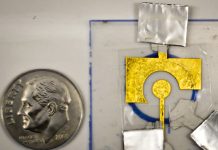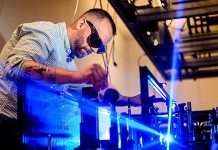
In a groundbreaking development, scientists led by Professor Bozhi Tian at the University of Chicago have created “living bioelectronics.”
This innovative technology combines living cells, gel, and electronics to interact seamlessly with living tissue.
The study, published in the journal Science, marks a significant advancement in the field of bioelectronics.
The team designed patches made from sensors, bacterial cells, and a gel composed of starch and gelatin.
Tests on mice demonstrated that these patches could continuously monitor and alleviate symptoms similar to psoriasis without causing skin irritation.
“This is a bridge from traditional bioelectronics, incorporating living cells as part of the therapy,” explained Jiuyun Shi, co-first author of the paper and now a researcher at Stanford University.
The project has been a decade and a half in the making, according to Tian. The researchers hope their principles can also be applied to other body parts, such as the heart or nervous system.
Pairing electronics with the human body has always been challenging due to the bulky and rigid nature of traditional devices like pacemakers. Tian’s lab focuses on understanding how living cells and tissue interact with synthetic materials.
Their previous work includes a tiny pacemaker controllable by light and flexible materials suitable for bone implants.
In this study, the team took a novel approach by adding living cells to the bioelectronics. They used the healing properties of bacteria like S. epidermidis, a microbe naturally found on human skin known for reducing inflammation.
The device they created has three components: a thin, flexible electronic circuit with sensors, an ultrasoft gel made from tapioca starch and gelatin, and S. epidermidis microbes embedded in the gel. When placed on the skin, the bacteria secrete compounds that reduce inflammation, and the sensor monitors skin conditions such as temperature and humidity.
Tests on mice with psoriasis-like skin conditions showed a significant reduction in symptoms. While initial tests lasted a week, the researchers hope the system, termed the ABLE platform (Active Biointegrated Living Electronics), could be effective for six months or more. The device can be freeze-dried for storage and easily rehydrated when needed.
“It’s like a living drug—you don’t have to refill it,” said Saehyun Kim, the other co-first author and a current Ph.D. student in Tian’s lab. Besides treating psoriasis, the scientists envision applications like patches to speed up wound healing in diabetic patients.
The team is also exploring the potential for other tissue types and cell types. “Could you create an insulin-producing device or one that interfaces with neurons?” Tian pondered. “There are many potential applications.”
Reflecting on the journey, Tian said, “To see it become reality has been wonderful.” Shi added, “My passion has always been to push the boundaries of what is possible in science. I hope our work inspires the next generation of electronic designs.”
The researchers utilized facilities at the University of Chicago and are working with the Polsky Center for Entrepreneurship and Innovation to commercialize the technology.
Source: University of Chicago.



